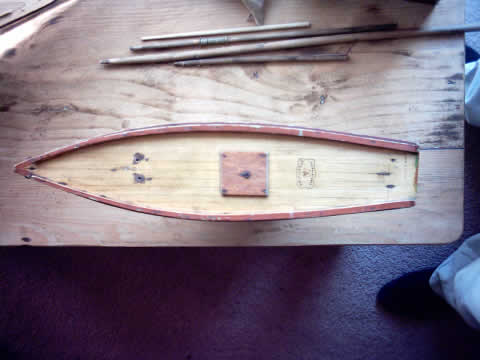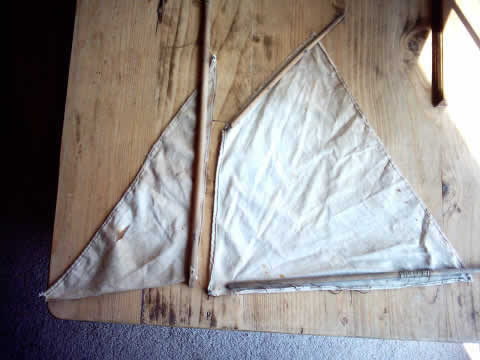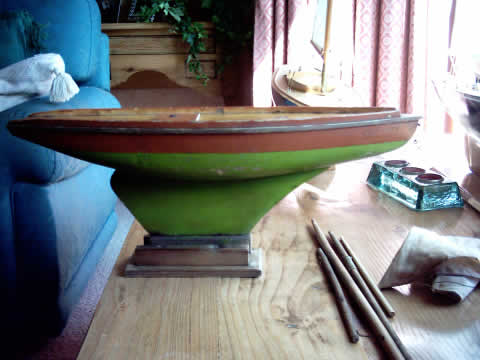I wonder if you can help me identify the 'toy' yacht I
recently bought on eBay. There appears to be the remnants of the name 'REGATTA'
on each side of the bow and the deck has stamped on it a makers mark depicting
'Navigable' and 'Made in France' . In the centre of the logo is a small 5
pointed star which contains the letters M.F.P. The model is carved from wood,
is 18" long (460mm) by 7" from bottom of keel to deck and has a
pencil lined deck which is tacked to the hull. The colours are in earthy green
and brown and the paint appear to be a satin and not a glossy finish.
I plan to bring the model back to a 'sailing' standard yet retain where possible
it's vintage charm and character. This is my first restoration I wonder if
you could provide any advice or tips.
I have cleaned the wood (mast and hull) using mild detergent and water to
take of the worst of the grime and am adverse to sanding or repainting which
would remove its years of character. Presently I am considered protecting
the surfaces using a number of coats of thinned varnish directly on top of
the existing finish to basically seal the wood, keel and masts as is!
Most of the deck and mast rigging fixing eyes have corroded and appear to
have been in the form of steel wire driven into the wood and bent over almost
to form a staple effect and loop. They have left prick type projection which
I cant repair so I have filed them down to be level with the wood these will
later be sealed under the varnish top coats.
The keel is cast iron, held on with two countersunk woodscrews, which I have
been able to remove, and has a number 9 or 6 stamped into it's top surface
which would normally be hidden. The keel appears to have been coated with
a gold paint to its surface. The mast block (fixing) is made from steel plate
,which is badly corroded, and has two holes to secure it to the deck. On each
side of the mast fixing, there are two holes, the top hole appears to have
acted as a pivot and matches with a protruding pin which is driven through
the base of the mast however the bottom hole which is about 5mm up from the
deck appears to have no purpose as there are no holes or pins at the base
of the mast to match it.
I have the mast and sails but no bowsprit which looking at the jib sail must
have been fitted as the sail would not fit properly. However front damage
to the bow suggests it may have sailed without this as it's slightly bashed!
The sails are cotton, thin, torn and need replaced I have searched for similar
material and have found that the cotton material used in the manufacture of
sleeping bag liners appears very similar and would like advice on its use
if perhaps used with a waterproof aerosol spray. There is no topsail so I
guess the model was too small for that addition. I plan to dye my new sails
in traditional 'cutch' dye to produce the tan colouring recreating that of
older sailing models which I think will enhance this particular model despite
the original sails appearing white.
I'm not sure how to rig this model and your help on this would also be appreciated.
The shrouds appear to have been fixed at four points each side of the deck
and the marks on the mast suggest they were connected at the top and 4"
above the point of connection of the main sail. There is no rudder so there
are no compensating tiller arrangement but you help would still be appreciated
on the overall rigging as I am a novice on this. I plan to use 'steel ' screw
type eyes to replace the staples but not sure what rigging thread to use.
Finally I have attached photographs to help you with your identification and
hope you can help on this as I would love to watch the Regatta take to the
water again!
BC



Comment from
Russlll Potts, Chairman VYMG
I saw this
on Ebay and thought it an interesting commercial model from a source that
I know little or nothing about. There is no mention of a company with the
logo MFP in Mering and Mestrot 'Canots et Voiliers de nos Bassins' (Paris,
2002), but it might be worth contacting them. Mering runs a shop in Paris
called 'Plein Gaz' and specialises in this sort of thing.
Their book does however have photos of boats from the 1930s, sold by a toyshop
called Vuitton, that have the deck legend 'Navigable, Made in France' and
the hull and fin forms are very similar to this boat. The mast tabernacle
is also similar in style. The Vuitton boats all seem to have been called 'Nova',
so this one, with a different name, may have been sold by the manufacturer
direct, ot through a different outlet.
As to your restoration proposals, it would be possible to seal all the existing
paint under coats of varnish, but you would need to be very sure that the
seal was good. Despite the attractions of keeping the aged appearance, I would
be inclined to go for a proper repaint. As the deck fittings are going to
have to be replaced, I would go for brass rather than replacing with more
steel, even to the extent of replacing the tabernacle.
The material you propose using for sails sounds as though it is very similar
to what we regard as the nearest current substitute for proper Union Silk
sailcloth, which is downproof cambric, which is used for lining cushions to
keep the feathers in. It is finely woven and waxed, so it is very nearly airtight,
avoiding the need to treat it any further.John Lewis, £3.95 per linear
metre x 56 inches wide (don't ask why!). I would advise against using a traditional
cutch on sails as delicate as these will be. It's filthy mixture and really
only appropriate for heavy flax sails on full size boats. If you want them
coloured, experiment with ordinary fabric dyes or tea and coffee. If you use
Tyvek, you can paint it with acrylic paints.
If you have any further queries don't hesitate to come back.
You may find books from the Curved
Air Press helpful.
| 